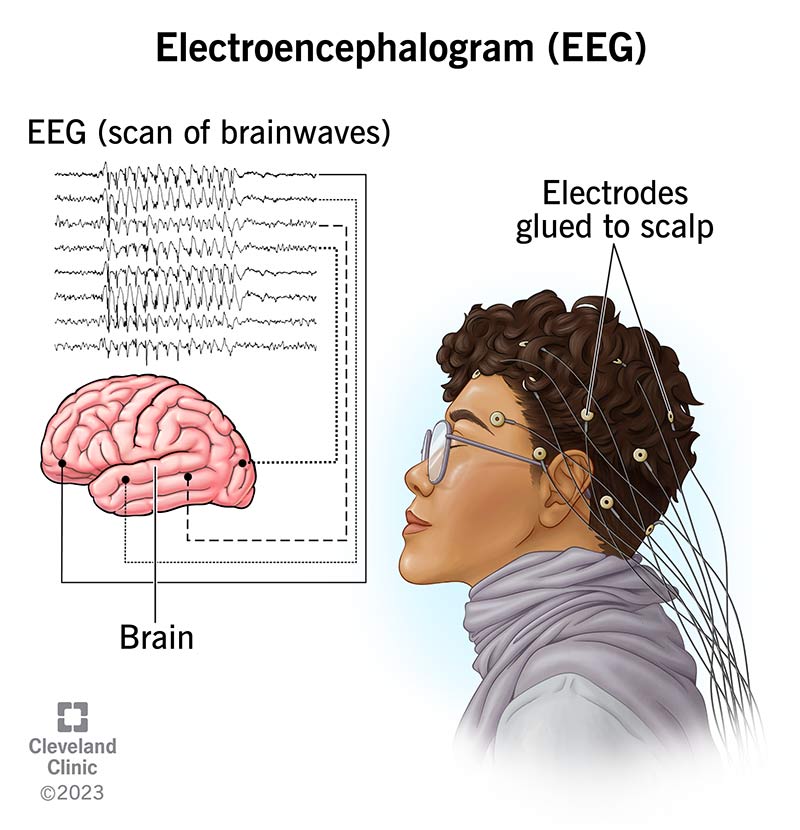An electroencephalogram (EEG) tests your brain function. Healthcare providers order EEGs to diagnose conditions that affect your brain. Providers may use the term EEG for the test itself and what it shows. In an EEG, electrodes placed on your scalp track your brain activity. The electrodes send information to a machine that records brain activity.

An EEG (electroencephalogram) is a test that measures your brain activity. Healthcare providers order EEGs to diagnose conditions that affect your brain. An EEG test measures the naturally occurring electrical activity arising from your brain.
During an EEG, a technician places small metal disks (electrodes) on your scalp. The electrodes attach to a machine that monitors the electrical signals that your brain cells (neurons) make to communicate with each other. Monitoring that communication shows how well the different areas of your brain are working.
Typically, healthcare providers order EEGs if you have seizures or if they think that you may have epilepsy. Your provider may order an EEG if you have symptoms that could be a result of an undiagnosed epileptic condition, including:
They may use EEGs to watch for signs of epilepsy if you have conditions like:
Cleveland Clinic is a non-profit academic medical center. Advertising on our site helps support our mission. We do not endorse non-Cleveland Clinic products or services. Policy
Healthcare providers order different EEG tests depending on the medical issue. EEG test types include:
An EEG works by measuring the electrical signals or impulses that travel between your brain cells. EEGs track those signals by using electrodes that attach to wires that sense electrical impulses. The electrodes:
There are different types of EEGs. Your healthcare provider will explain the kind of test you’ll have, including why they’re doing a specific test, what will happen during the test, how long it will take and if you need to have someone to take you home after the test. Regardless of the type of EEG test, you should:
During a routine EEG:
A routine EEG may take 20 to 30 minutes to complete.
Your technician will remove the electrodes and clean the part of your scalp where they placed the electrodes. Unless your provider tells you otherwise, you can go home and go about your day. Your hair and skin may feel sticky from the glue or paste that kept the electrodes in place during your EEG, so you may want to wash your hair when you get home.
EEGs rarely cause side effects. Some people may feel dizzy while taking deep breaths during the test. If you have certain forms of epilepsy, deep breathing (hyperventilation) or light (photic) stimulation during the EEG may trigger an epileptic seizure. This doesn’t happen very often, and if it does, your technician will know what to do to help you during a seizure. You may lose some hair or have skin irritation where the electrodes were on your head.
You’ll have a follow-up appointment with your healthcare provider. They’ll review the brain wave patterns that the test shows.
Your healthcare provider is your best resource for insight into your test results. They’ll look for abnormal brain waves or rhythms, which may indicate brain dysfunction or epileptic activity.
That depends on your situation. Your healthcare provider may refer you to a specialist, like a neurologist, who can diagnose, treat or manage your condition.
An EEG (electroencephalogram) is a safe, painless test that measures brain activity. Your healthcare provider may order an EEG to find out why you have certain symptoms like seizures, confusion or memory loss. They may use the term EEG to describe both the test (electroencephalography) and test results (electroencephalogram). Having an EEG is the first step toward discovering why you have seizures or other brain disorders.
Last reviewed by a Cleveland Clinic medical professional on 03/08/2024.
Learn more about our editorial process.
Cleveland Clinic is a non-profit academic medical center. Advertising on our site helps support our mission. We do not endorse non-Cleveland Clinic products or services. Policy